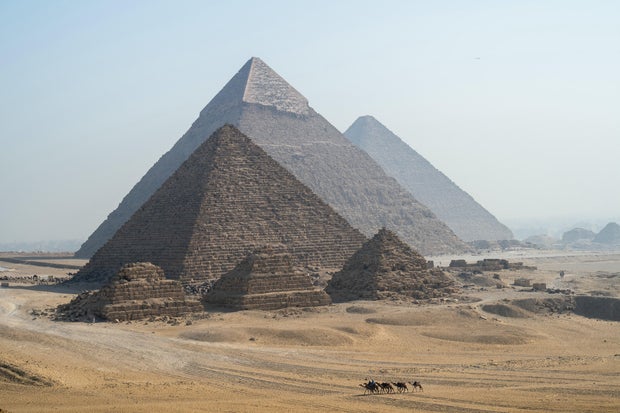Scientists have discovered a long-buried branch of the Nile River that once flowed alongside more than 30 pyramids in Egypt, potentially solving the mystery of how ancient Egyptians transported the enormous blocks of stone to build the famous monuments.
The 40-mile-long branch of the river, which passes through the iconic Giza pyramid complex, among other wonders, has been hidden beneath desert and farmland for millennia, According to a study revealing the discovery on Thursday.
The existence of the river would explain why the 31 pyramids were built in a chain across a now inhospitable desert strip in the Nile Valley between 4,700 and 3,700 years ago.
The range near the ancient Egyptian capital of Memphis includes the Great Pyramid of Giza – the only surviving structure of the seven wonders of the ancient world – as well as the pyramids of Cheops, Cheops and Mykerinos.
Archaeologists have long thought that the ancient Egyptians must have used a nearby canal to transport the giant materials used to build the pyramids.
“But no one was sure of the location, shape, size or proximity of this navigable megaway to the actual site of the pyramids,” the study’s lead author, Eman Ghoneim, from the University of North Carolina at Wilmington, in the United States, told AFP. .
JÓIA SAMAD/AFP via Getty Images
The international team of researchers used radar and satellite images to map the branch of the river, which they named Ahramat – “pyramids” in Arabic.
Radar gave them the “unique ability to penetrate the surface of the sand and produce images of hidden features, including buried rivers and ancient structures,” Ghoneim said.
Field surveys and sediment collections from the site confirmed the presence of the river, according to the to study in Communications Earth & Environment magazine.
The once-mighty river was increasingly covered in sand, potentially starting during a major drought about 4,200 years ago, scientists suggested.
“Easier to float down the river”
The pyramids of Giza stood on a plateau about a kilometer from the banks of the river.
Many of the pyramids had a “ceremonial elevated walkway” that ran along the river before ending at the Valley Temples, which served as ports, Ghoneim said.
This indicates that the river played “a key role in transporting the enormous construction materials and workers needed to build the pyramid,” he added.
Exactly how the ancient Egyptians managed to build such enormous and enduring structures has been one of history’s great mysteries.
These heavy materials, mostly from the south, “would have been much easier to float down the river” than to transport overland, study co-author Suzanne Onstine of the University of Memphis told AFP.
The banks of the rivers could have been where the pharaohs’ funeral processions were received before their bodies were transferred for “final burial within the pyramid,” she suggested.
The river may also indicate why the pyramids were built in different locations.
“The course of the water and its volume changed over time, so the kings of the Fourth Dynasty had to make different choices than the kings of the 12th Dynasty,” she said.
“The discovery reminded me of the intimate connection between geography, climate, environment and human behavior.”
The study follows recent research projects focusing on the iconic pyramids.
Earlier this year, archaeologists launched a massive projectt to restore the smallest of Giza’s three famous pyramids to what they believe it was when it was built more than 4,000 years ago. An Egyptian-Japanese archaeological mission announced the project to replace hundreds of granite blocks that formed the outer covering of King Menkaure’s pyramid.
Some archaeologists, however, including a former head of Egypt’s antiquities ministry, do not agree with the project and have expressed concern as excavation begins. Mohamed Abd El-Maqsoud, former director of the Egyptian Antiquities Sector and former senior official at Egypt’s Ministry of Antiquities, told CBS News that before the granite blocks were moved, they should first be studied extensively to see if they all did. part. of the structure to begin with.
Last year, a team of archaeologists and other scientists in Egypt used cutting-edge technology that relies on beams of radiation from space to obtain a sharp image of a 30-foot-long object. corridor inside the Great Pyramid of Gizawhich remains hidden behind a main entrance to the old structure.
Ahmed Shawkat contributed to this report.























